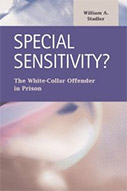Special Sensitivity? The White-Collar Offender in Prison
 Author: William A. Stadler
Author: William A. Stadler
Publisher: El Paso, TX: LFB Scholarly Publishing LLC, 2012. 180p.
Reviewer: Jessica Schmidt | July 2013
Past sentencing decisions for white-collar offenders were influenced by the assumption that imprisonment was more harmful to these offenders than it was to non-white-collar offenders. Sentencing guidelines have contributed to an increased proportion of white-collar offenders being sentenced to prison. However, the "special sensitivity" assumption continues to be used at sentencing as a mitigating factor. William A. Stadler identifies the need to empirically test whether a "special sensitivity" to imprisonment actually exists in white-collar offenders. In Special Sensitivity? The White-Collar Offender in Prison, Stadler examines both white-collar and non-white collar offenders to identify differences in multiple indicators, including demographic, social, criminal history, attitude, motivation, personality, and prison adjustment. He then examines those differences to determine if a "special sensitivity" is present in white-collar offenders.
Special Sensitivity? follows the same format as a research project. Stadler begins by establishing the need for the current research and provides a thorough literature review that identifies where Special Sensitivity? fills the gaps in our current knowledge. The end of the literature review introduces three research questions that will be addressed in the remainder of the book. A chapter describing the methodology is provided, followed by a chapter where the univariate, bivariate, and multivariable statistical analyses are presented. The differences found between the two groups are discussed. Based on these findings, Stadler concludes that there is no "special sensitivity" to imprisonment for white-collar offenders. In some cases they may adjust more easily than non-white-collar offenders. The final chapter reminds us again of the need for this study, the possible implications, the strengths and weaknesses of the research project, and the pressing need for future research. Stadler’s use of tables throughout the book provides a visual examination of the statistical analyses and helps readers to gain a better understanding of the findings.
Special Sensitivity? is a major contribution to the literature on imprisoned white-collar offenders. As one of the first to empirically test the "special sensitivity" hypothesis, Stadler contributes to filling the gap in our knowledge and understanding about white-collar offender’s adjustment to prison. Special Sensitivity? has numerous possible implications for how we deal with white-collar criminals at all levels of the criminal justice system. Valuable information can be gained for everyone who deals with issues associated with the incarceration of white-collar offenders, including legislators, judges, correctional practitioners, prison officials, researchers, and scholars.
The greatest shortcoming of Special Sensitivity? is the lack of generalization that can be made from it. Stadler acknowledges that the use of data that is over twenty years old from two male federal prisons in Illinois contributes to its limitations. While we may not be able to generalize from the information across geographic location, jurisdiction, or gender, it does introduce the need for more research to be conducted on the "special sensitivity" of white-collar offenders. One frustration for a reader is that are several references to an Appendix that is not included.
Special Sensitivity? is nevertheless a valuable addition to the study of white-collar offenders. Despite its limitations, the book adds to the existing literature about white-collar offenders and their imprisonment. It is likely to spur future research and changes in the criminal justice system.
Jessica Schmidt
American Military University
jschmidt819@gmail.com


